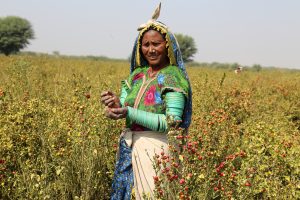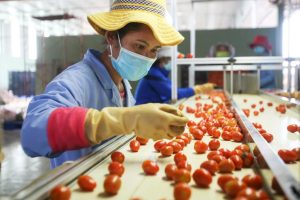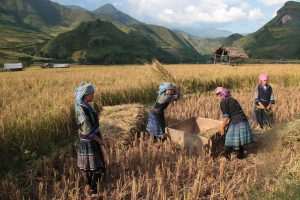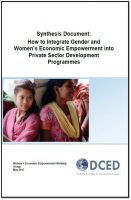Women’s Economic Empowerment: Seven key take-aways from recent original research

In almost every part of the world, women have less access to productive resources and work, and see fewer benefits of their labour than men. It’s not surprising that women’s economic empowerment (WEE) is now seen as one of the greatest opportunities for global growth and social well-being. As a result, most donor agencies now prioritise it in their economic development programmes – whether that’s in the reform of regulatory frameworks, facilitation of inclusive business models and markets, or promotion of entrepreneurship.
As much as WEE seems desirable for development practitioners, there is still limited knowledge on what influences the success of their programmes and how they can avoid doing harm while operating in complex socio-cultural environments. Evidence is therefore key to influence policy makers and inform programme design.
This month, the Donor Committee for Enterprise Development (DCED) has published an Update on some of the latest empirical research on WEE. We looked primarily at original studies published in academic journals that have practical implications for programming. In addition, we have signposted more than 15 recent literature reviews, case studies and new guidelines for practitioners by the DCED and others.
Seven key take-aways emerge from the research reviewed:
- There are persistent gender gaps in the economic empowerment of women and men in the agricultural sector, across different countries. Recent analyses in Malawi, Tanzania and Uganda show significant gaps in agricultural productivity between men and women. Women are also less likely than men to engage in more profitable activities, like export crops. Addressing the gender gap could increase crop output by 2.1 % in Tanzania, 2.8 % in Uganda, and 7.3 % in Malawi. Limited access to land is further preventing women from engaging in productive agriculture. In Ghana, for example, men have up to 80% more land access and crop acreage than women.
-

Economic transformation offers new opportunities for entrepreneurship, wage labour and social empowerment, but women often benefit less from these than men. In Cambodia, the shift in employment out of agriculture and into industry has been greater for men than women; vulnerable employment has fallen more for men than for women; women’s businesses are less profitable; and women benefit less from wage work than men. The IFC has published a guide for practitioners on how to make the business case to companies for reducing such gender gaps. In some places, manufacturing has already offered new social and economic benefits for women: In Bangladesh, garment factories have increased employment and educational attainment for women living nearby; and in Mexico, demand for female labour in the manufacturing sector has positively affected women’s bargaining power in the household.
- In the agricultural sector, successful country-specific solutions to WEE have often focused on addressing the most binding constraints, or enhancing women’s participation in markets that they are already active in. Countries can maximise their economic gains by focusing on the most binding productivity constraints for women – in Uganda for example, a priority would be women’s access to agricultural machinery, which has the potential to increase GDP by over $11 million. In Ethiopia, a land certification programme had a positive effect on productivity across households, and in particular for female-headed households. It is also critical to use existing roles and markets of women as entry points when designing programmes: In Kenya, for instance, cash crops offer higher selling prices, but also higher entry barriers for women. Instead of switching to new crops, women have successfully increased their incomes from traditional produce by working together in farmer groups. Other studies have found gender differences in climate change adaptation strategies: women in Kenya mainly focus on crop-related strategies, whereas men deal with livestock and agroforestry-related strategies. This points to the need of gender-sensitive interventions.
- Some regulatory reforms and agricultural value chain interventions are found to have social empowerment benefits, and these benefits
- often seem to increase over time.
 Women’s land ownership, and transfer of agricultural and animal assets combined with training have increased women’s household decision-making power in Nepal, Ethiopia and Burkina Faso respectively. Sustainability standards in coffee production (UTZ, and organic or Fairtrade certification) seem to have had a positive impact on women’s empowerment in Uganda: When a household is certified, the probability that a man alone controls coffee revenues is reduced by 66%. Behavioural changes conducive to empowerment also increase over time: The longer households have been certified, the less likely it is that men alone control coffee production and revenues.
Women’s land ownership, and transfer of agricultural and animal assets combined with training have increased women’s household decision-making power in Nepal, Ethiopia and Burkina Faso respectively. Sustainability standards in coffee production (UTZ, and organic or Fairtrade certification) seem to have had a positive impact on women’s empowerment in Uganda: When a household is certified, the probability that a man alone controls coffee revenues is reduced by 66%. Behavioural changes conducive to empowerment also increase over time: The longer households have been certified, the less likely it is that men alone control coffee production and revenues.
- There is however also new evidence that economic development programmes have not always been effective in addressing binding constraints for women. A new study on microenterprise support in Uganda suggests that social norms often prevent women from realising benefits from conventional interventions. It shows that men benefit from a package of microloans and training, leading to a 54 % increase in profits and similar effects on employment. However, women realize no impacts, whether they received loans, grants, training, or any combination of these. These results apparently relate to control in the household. Only when women are willing to ‘hide’ money from their husbands, they are able to keep control of it and use it for business growth. In some contexts, programmes may therefore need consider success metrics other than profit maximisation, such as women’s investments into the household’s needs, which may be more achievable in the near term.
- Recent research is inconclusive on the relationship between WEE and partner violence, but programmes can probably do more to reduce the risk of doing harm. Overall, research findings suggest that the risk of increased partner violence as a result of women’s increased access to economic resources is highly context-specific. For example, earning income or owning a business seems to increase women’s exposure to partner violence in Dar es Salaam, but not in another Tanzanian town. In Uganda, joint participation of partners in a micro-enterprise programme seems to have increased the quality of relationships.
 Several new resources aim to support programme in gender-sensitive and/or WEE-focused design and results measurement – something that many studies recommend in order to achieve better WEE outcomes. Guidelines and complementary resources are available on most of the issues listed above. The DCED itself has published a new Synthesis Document that draws together resources and guidance on integrating gender and WEE into project cycle of PSD programmes. The DCED has also published new guidance, a policy brief and case studies on gender-sensitive Business Environment Reform.
Several new resources aim to support programme in gender-sensitive and/or WEE-focused design and results measurement – something that many studies recommend in order to achieve better WEE outcomes. Guidelines and complementary resources are available on most of the issues listed above. The DCED itself has published a new Synthesis Document that draws together resources and guidance on integrating gender and WEE into project cycle of PSD programmes. The DCED has also published new guidance, a policy brief and case studies on gender-sensitive Business Environment Reform.
For more evidence on pro-poor impacts of private sector development, take a look at the DCED Evidence Framework. You can also find more research and case studies on WEE on the Women’s Economic Empowerment knowledge page. If you have any comments, or know of any other new research that should be included, please let us know via heinrich@enterprise-development.org.
Photo credits: Saira Habib, MDF; Phong Thuy; Ed Henley
This blog is a part of the September 2017 series on Empowering women, in partnership with SPRING.
Read the full series for insights on business models that empower girls and women, a new analysis of gender impacts of value chain interventions, tips on gender-lens investing and many inspiring personal stories from women.